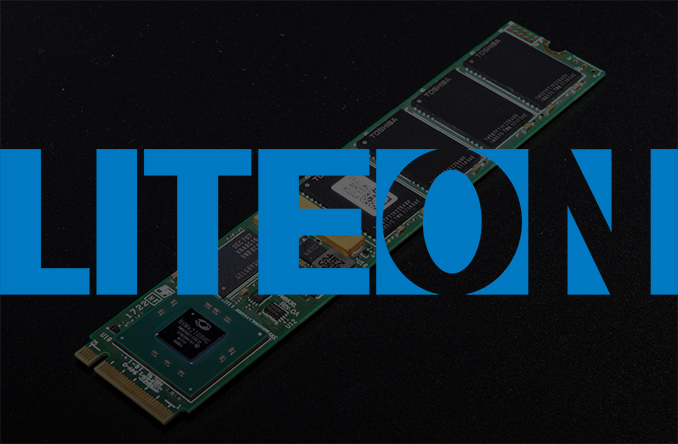Lite-On and Tsinghua Unigroup Create $100 Million Joint Venture for SSD Operations in China
by Anton Shilov on January 5, 2018 6:00 PM EST
Lite-On has announced that it had signed an agreement with Tsinghua Unigroup to establish a joint venture in China. The JV will develop and build SSDs in Suzhou. The registered capital of the new entity will be $100 million, which is relatively high - well beyond the cost of building and outfitting a plant with SMT placement equipment to install controllers and NAND memory on PCBs.
Under the terms of the agreement, Lite-On invests $45 million for a 45% stake in the joint venture as well as two seats in its board of directors, whereas Tsinghua Unigroup invests $55 million for a 55% stake and three seats. The JV will be managed by co-CEOs proposed by the two shareholders. The co-CEO from Lite-On will be responsible for supply chain and manufacturing, whereas the co-CEO from Tsinghua will be responsible for business/product planning and identification of market segments.
The two companies plan to start construction of the plant in early 2018 and complete it in Q4 2018. Lite-On expects the Suzhou JV to contribute to its revenues in 2019, after it starts production and sales of drives. The volumes produced by the JV are going to be an interesting aspect to consider. Typically companies do not share costs of their production facilities, but from various reports we do know that a PCB assembly line needed to produce SSDs costs millions, but not tens of millions. Therefore, a $100 million investment means that the Lite-On-Tsinghua joint venture intends to build a large SSD production facility. Lite-On stresses that at this time it does not have plans to develop its own SSD controllers, so it would be prudent to assume that all the money will be used for the factory and business development. It remains to be seen whether NAND flash and controllers procured to build drives at a JV could be used to make products under the Lite-On and/or Plextor brands.
Tsinghua Unigroup is a Chinese state-controlled multi-billion high-tech holding company that has a lot of ties in the country. The corporation runs multiple businesses and consumes a lot of SSDs itself, so the JV is going to have plenty of umbrella clients to sell its products to. Meanwhile, it is noteworthy that earlier this year Tsinghua Unigroup announced plans to invest $30 billion in a DRAM and NAND fab in Nanjing. If the semiconductor entity obtains necessary technologies and IP to make competitive memory, then the SSD maker controlled by Lite-On and Tsinghua Unigroup might also get NAND supply from a sister company. However, it is too early to make forecasts for the future.
Related Reading
- Inside OCZ's Factory: How SSDs Are Made
- Lite-On Announces Enterprise EPX M.2 NVMe SSDs: 3D TLC, Up to 1920 GB, 1800 MB/s
- Lite-On Adds MU X SSD to Lineup: Phison PS5008-E8, 3D TLC, Up to 1600 MB/s
- Lite-On Launches CA3 M.2 NVMe SSDs: Up to 1TB, 2.9 GB/s, Marvell 88SS1093
- Lite-On SSDs At FMS: New Controllers And TSV NAND Packaging
Sources: DigiTimes, Lite-On










6 Comments
View All Comments
vladx - Friday, January 5, 2018 - link
Finally SSD price drop incoming.Pork@III - Saturday, January 6, 2018 - link
SSD`s price drop is permanent. Problem has with DRAM prices.iwod - Saturday, January 6, 2018 - link
That is coming soon. Tsinghua Unigroup ( its Subsid )is going to compete with Samsung with DRAM and NAND pricing. This is China taking its first step into the Semiconductor Fabs industry.DanNeely - Saturday, January 6, 2018 - link
A modernish semi-conductor fab costs billions; PCB integration's much farther down the price/complexity scale.Lolimaster - Saturday, January 6, 2018 - link
I think they need to shrink their 2.5" drive cases. They want to cheap out with TLC or DRAMless when they should simply reduce volume and actually reduce shipping prices to all transport/housing chain.DanNeely - Sunday, January 7, 2018 - link
You really don't have an ability to shorten them, the mounting screw holes are very close to the corners of the drive and many tool-less designs that just stick pins into them need bot the front and rear pairs of holes to hold the drives securely.If it wasn't for M.2 trying to kill the entire form factor off I suspect we would see a either a half lengthish 2.5" short form factor or a revival of the 1.8" sata form factor for SSDs with cheap 2.5" to 1.8" adapters in the box (similar to how many early SSDs included 3.5" to 2.5" brackets to aid installing in desktop cases that rarely had 2.5" bays.
As it is, I expect we'll continue to see sub-sized PCBs in 2.5" carriers from now until the form factor slowly fades away. Older systems and the upgrade market mean that's probably at least 5 years out.